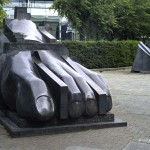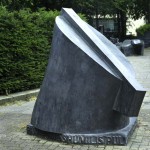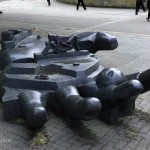The Manuscript of Monte Cassino by Eduardo Paolozzi
21 Oct 2015, by in LearningThe Manuscript of Monte Cassino (1991), situated in Edinburgh’s Picardy Place, is one of the most powerful artworks created by Eduardo Paolozzi. It poignantly explores the destruction brought about by war and at the same time offers a message of peace, hope and regeneration.
Paolozzi’s family came from the village of Viticuso, near Cassino in Southern Italy, site of one of the worst battles of WW2. It was here that the bombing of the ancient monastery of Monte Cassino occurred in 1944, and through his sculpture the artist acknowledges this deeply tragic event.
The public sculpture is situated opposite St Mary’s Catholic Cathedral, in the old Italian area of the city, where he was born and grew up. Thus it nods at the plight of those Italians, like his own family, who were living in Scotland during the war, when many of them were declared ‘enemy aliens’.
He conceived this multipart colossus in such a way that passers-by can walk and sit among the fragments and children can play on it, paddling in the little pools of water. Around the base of the huge bronze foot and hand, he has inscribed some Latin words taken from….
Photos © Luigi Giannetti
Project 1
The Manuscript of Monte Cassino – an App by Margaret Rose
Listen to Margaret’s interview
Project 2
Call for writers of short stories in response to The Manuscript of Monte Cassino
Paolozzi’s Biography
Eduardo Paolozzi (Edinburgh, 7 March 1924 – London, 22 April 2005) was one of Britain’s leading twentieth century sculptors and artists. He is often considered the father of British Pop art, but this isn’t the part of his work that interests us here.
At sixteen he lost his father, grandfather and uncle when the Arandora Star, a liner deporting Italian prisoners of war to Canada, was torpedoed by a German U Boat and sank on 2 July 1940. They were just three of the Italian men, who in July 1940, following Benito Mussolini’s declaration of war on Great Britain and France, were declared enemy aliens by the British Government. There were 1864 men onboard the Arandora, among whom 1200 Italian and German internees. 734 men were drowned, 446 were Italians. While Paolozzi never spoke about the tragedy, except in very matter of fact terms, it appears in the images of war, anonymous prisoners and shattered heads that relentlessly resurface in his art. In the collages and in some of his other works, these are juxtaposed with playful, ironic, even optimistic images.
Paolozzi’s life, likewise, reflects his unwillingness to be made bitter by wartime events; he once described himself as “a curious kind of European hybrid on the English landscape” (London 1994), indicating how he had a complex identity made up of two cultures (British and Italian) and four languages (English, Scots, Italian dialect and Italian). In other words he thought of himself as European first and foremost, his national identity took second place. In the aftermath of WW2, it is significant that he goes to work in France, America and Germany, where he forges artistic connections and friendships with the people there.
While reticent to put his experiences into words, his huge public artworks make important statements. Through them he communicates with thousands of people, who see the artworks every day, as they are walking through Edinburgh, Munich or London, travelling on the London Underground, or visiting London’s British Museum library.





Sorry, the comment form is closed at this time.